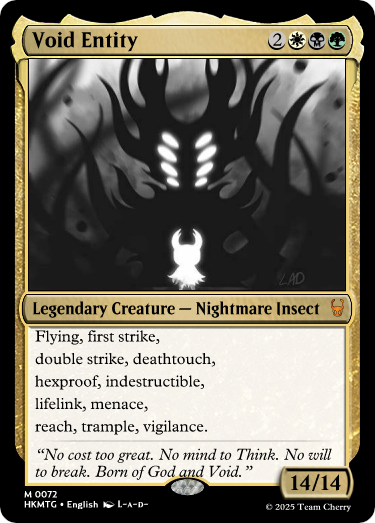First of all, you should know that this is not a typical Kathril deck — this deck is a tribute to the game Hollow Knight. The custom card skin for each card in the deck can be found at the following link: Hollow Knight, Magic: The Gathering
Only then will you begin to understand this Primer.
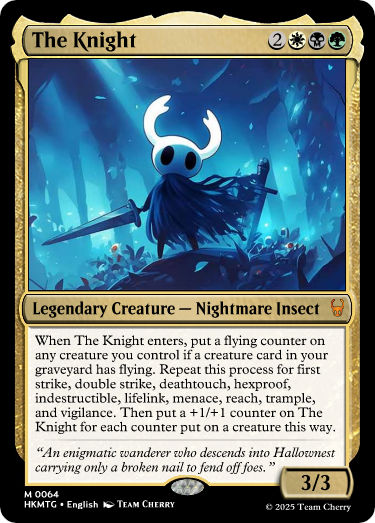
"Higher beings, these words are for you alone.
Beyond this point you enter the land of King and Creator.
Step across this threshold and obey our laws.
Bear witness to the last and only civilisation, the eternal Kingdom.
Hallownest."
When I first saw the Kathril card, I saw The Knight himself in it; in my view, everything about the card represented him. At the start of Hollow Knight, you can be seen as a 3/3 vanilla creature; then, as the game progresses, you might become a 4/4 with Flying, for example, if you got the Monarch Wings. Everything depends on how much you’ve explored Hallownest, how many bosses you’ve faced and defeated, how many NPCs you’ve encountered and helped... in the same way, Kathril, Aspect Warper evolves in a Commander match.
That’s where my journey began. After all, if Kathril could be the Knight, then who knows what each of the other cards in his future deck could be? What ability in the game would represent each keyword in MTG? That line of thinking was the trigger that made me want to adapt each card in this potential deck. I thought it would be more practical to start with the keywords and go to the extremes: Who are the strongest creatures in Hallownest? They would probably be represented by the strongest creatures in the deck. And that’s exactly what I did.


Flying would clearly be the Monarch Wings, and Reach would obviously be the Mantis Claws... okay, it’s a start — we can work with that. Let’s move on to the creatures.

Zetalpa, Primal Dawn was originally envisioned as The Radiance, since he is the final boss of the game. But the fact that he only has 4 power felt odd, because even though Double Strike virtually gives him 8 power, that’s not the impression you get just by looking at the card. So, Radiance became Avacyn, Angel of Hope instead: 8/8 in her utopian and eternal realm, indestructible.
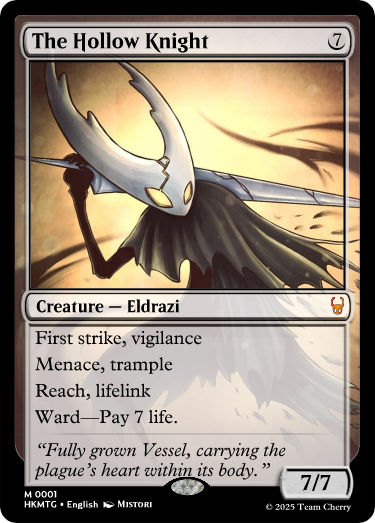
The Hollow Knight, in turn, is the Sire of Seven Deaths. He comes close to Radiance in raw power, while also resembling the Knight himself, since both are French Vanillas. Both are Vessels. In a game of Commander, the Knight can become as close to the Sire of Seven Deaths as possible. That’s why I chose Sire of Seven Deaths as The Hollow Knight.


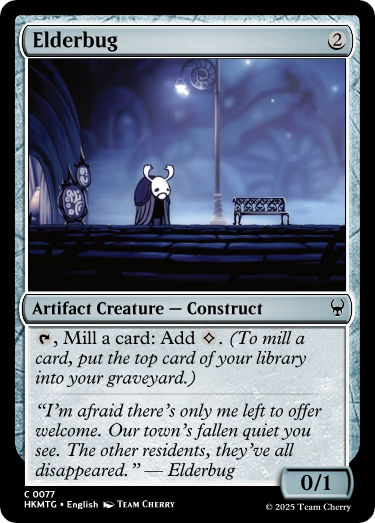
One very common effect in the deck is self-mill. In Magic, the Explore mechanic lets you look at the top of your library and potentially grab a land; and from that idea, I built the principle that most self-mill effects represent your exploration of Hallownest, or your knowledge about it. Some NPCs even help with that, either by talking about a place or by giving you an item that aids in exploration. (That’s why Elderbug is Millikin, a weak 0/1, that tells you many stories about the world.) Based on that principle, I chose Lumra, Bellow of the Woods as the representative card for Hornet; not only does she help you a lot by uncovering the mysteries of Hallownest, but she can also be weaker or stronger depending on the point in the story where you encounter her—just like the Knight!
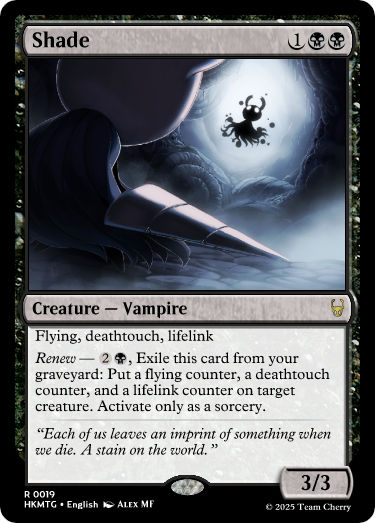
One of the creatures whose effect I enjoy the most is the Shade, which is the Qarsi Revenant. I find its effect really fun, because once it’s in the graveyard, using its ability feels like you’ve defeated your own Shade in the game and regained its powers (Soul, Geo, etc).
And that’s how I continued choosing creatures — the smaller ones are simple NPCs, while the larger ones are bosses from the game.




The rest of the deck’s cards are mostly loot effects, reanimation spells, and lands, which correspond respectively to the game's shops; the awakening of the dreamers (or npcs that recover stuff); and areas of the map. (You might have noticed I also included two Moxen as Kingsoul & Void Heart; in a budget version of the deck, they can be replaced with Wild Growth and Utopia Sprawl, which in turn represented the Bench and the Whispering Root from the game.)
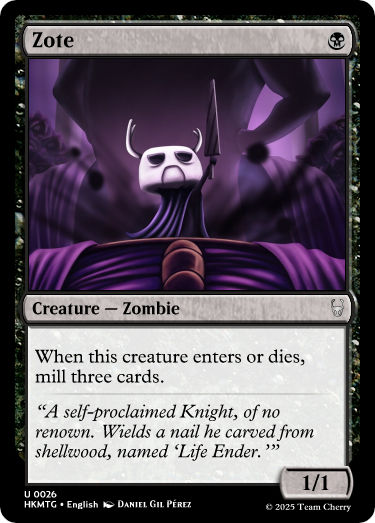
Some cards didn’t translate so well, unfortunately. Massive Moss Charger being an 7/6? A bit exaggerated. (At least Hexproof occasionally represents elusive creatures in Magic, and trample also fits well with it's behavior in-game), Howling Wraiths representing Menace? Not great, but some details we can overlook. Zote being just a 1/1 that contributes without contributing — or contributes by dying? Okay, that actually does feel like Zote.
Oh, and there's also the big elephant in the room: the typeline. Unfortunately, that's something that can't be avoided, in the perfect world all creatures would be insects, fungi, plants, gods, etc. I opt to ignore it, or view it for another angle, and focus on all the other aspects of the cards.
I could go on and on explaining every card and what each one had that made me choose it, but I trust you can understand most of the reasoning if you analyze the power curve, the keywords, and some of their abilities.
And that’s it. I had a blast making these skins — and even more fun playing with them in person! I hope you enjoy them too!
"Higher beings, these words are for you alone.
These blasted plains stretch never-ending. There is no world beyond.
Those foolish enough to traverse this void must pay the toll and relinquish the precious mind this kingdom grants."
Now, a few words about the deck construction itself, and how it operates:
First of all, know that this is a Bracket 3 deck, and beyond that, I don’t like using tutors in Commander. For me, they take away a big part of the fun and excitement I get from building my game state organically, while a narrative is being created; so no Buried Alive, Entomb, etc.
With that in mind, I chose to include as many self-mill effects as possible—whether through sorceries, instants, or even creatures, artifacts, and enchantments. I prioritized the ones that can get lands while milling, like Grapple with the Past, because they double down as a way to dig for lands, so you don't miss your land drops even with the (kinda) low amount of lands that the deck has. (Also, the lack of card draw)
To complement the ways of putting cards into the graveyard, I added some looting effects, in cards like Collector's Vault or Geier Reach Sanitarium (not many, unfortunately, due to the deck’s color identity).
I tried to include as many keywords as possible, spread as evenly as I could across the creatures; I even prioritized mana dorks with keywords, like Sylvan Caryatid or Nightshade Dryad.
As for the bigger creatures, I considered not only their keywords but also their other effects whenever possible, for example:
Ashen Rider, Vona, Butcher of Magan, and Alpha Deathclaw serve as removal (usually when reanimated), in addition to their solid keywords.
Angel of Destiny is included not just for its two great keywords, but also because its last effect is reasonably easy to trigger in this deck—especially since the commander, when at its best, can gain you 44 life if it has lifelink and the Angel is on the battlefield, so sometimes you can take two opponents at once, one with Kathril, and the other with the Angel.
Cataclysmic Gearhulk is a pseudo-sweeper while also providing a keyword. The same goes for Massacre Girl.
Since the deck has essentially no card draw effects, I included some spells with flashback/unearth, like Priest of Fell Rites and Unburial Rites; that way, if they end up in the graveyard through self-mill, it's almost like having them in hand—so in a way, it's like drawing a card.
Regarding the lands, I added High Market and Lazotep Quarry as ways to sacrifice creatures, providing another method to put them into the graveyard if needed. I also added Shifting Woodland, which can enable several interesting plays—for example, copying Angel of Destiny in the graveyard at the right moment to immediately trigger its ability, bypassing the need to wait a turn due to the deck's lack of Haste. I also included Swarmyard because it has good synergy with the commander, but this slot can be replaced with your preferred utility land, such as Homeward Path or Hall of the Bandit Lord, for instance.
Regarding mana costs, the deck ended up with many cards at the two-mana curve. This means that if you cast a two-cost mana dork on turn two, on turn three you’ll have four mana and can cast two two-cost spells for maximum effect. (Ideally two self-mill effects, so that on the next turn, with five mana, you can cast your commander with a good number of keywords.)
Although most creatures in the deck aren't the type to dominate the game on their own (maybe only Avacyn or Zetalpa if they enters real early), the deck does have a Plan B: Reanimate. With the whole self-mill package, it is commom to have a good enough creature on the graveyard early on, and when that happens, it may be better to reanimate one of then instead of casting your commander. Afterwards, if you cast Kathril, you might want to give this creature some keywords, like hexproof or indestructible, instead of placing them on kathril, etc.
And that’s it!
Thank you.
Bonus image of the Knight (Kathril) if it gets each possible keyword:
